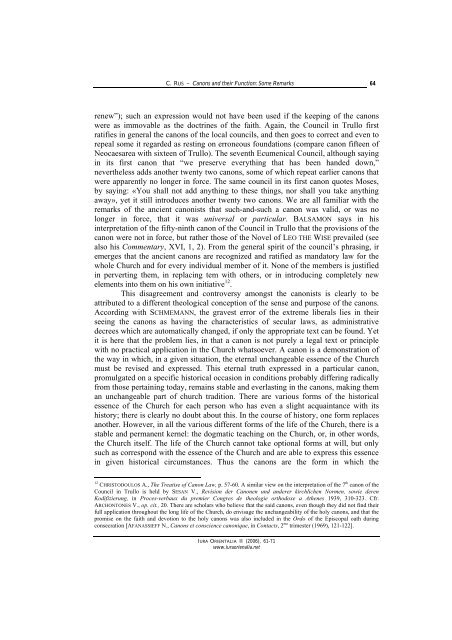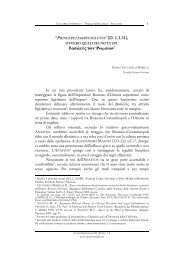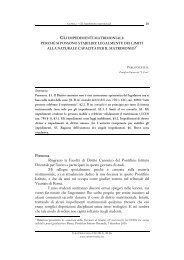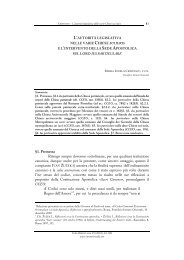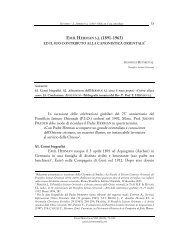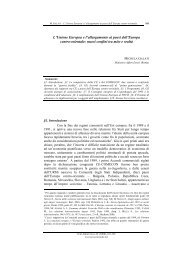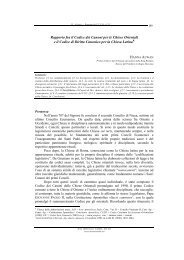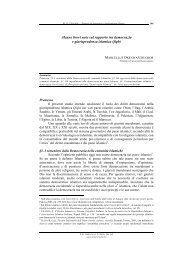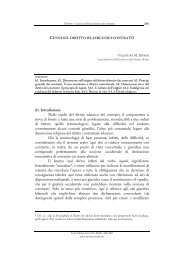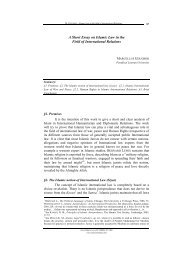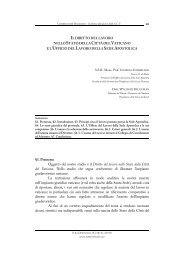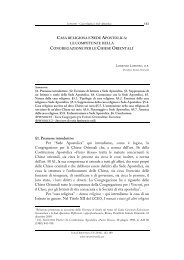The Canons of the Church and their ecclesiastical ... - iura orientalia
The Canons of the Church and their ecclesiastical ... - iura orientalia
The Canons of the Church and their ecclesiastical ... - iura orientalia
You also want an ePaper? Increase the reach of your titles
YUMPU automatically turns print PDFs into web optimized ePapers that Google loves.
C. RUS – <strong>Canons</strong> <strong>and</strong> <strong>the</strong>ir Function: Some Remarks64renew”); such an expression would not have been used if <strong>the</strong> keeping <strong>of</strong> <strong>the</strong> canonswere as immovable as <strong>the</strong> doctrines <strong>of</strong> <strong>the</strong> faith. Again, <strong>the</strong> Council in Trullo firstratifies in general <strong>the</strong> canons <strong>of</strong> <strong>the</strong> local councils, <strong>and</strong> <strong>the</strong>n goes to correct <strong>and</strong> even torepeal some it regarded as resting on erroneous foundations (compare canon fifteen <strong>of</strong>Neocaesarea with sixteen <strong>of</strong> Trullo). <strong>The</strong> seventh Ecumenical Council, although sayingin its first canon that “we preserve everything that has been h<strong>and</strong>ed down,”never<strong>the</strong>less adds ano<strong>the</strong>r twenty two canons, some <strong>of</strong> which repeat earlier canons thatwere apparently no longer in force. <strong>The</strong> same council in its first canon quotes Moses,by saying: «You shall not add anything to <strong>the</strong>se things, nor shall you take anythingaway», yet it still introduces ano<strong>the</strong>r twenty two canons. We are all familiar with <strong>the</strong>remarks <strong>of</strong> <strong>the</strong> ancient canonists that such-<strong>and</strong>-such a canon was valid, or was nolonger in force, that it was universal or particular. BALSAMON says in hisinterpretation <strong>of</strong> <strong>the</strong> fifty-ninth canon <strong>of</strong> <strong>the</strong> Council in Trullo that <strong>the</strong> provisions <strong>of</strong> <strong>the</strong>canon were not in force, but ra<strong>the</strong>r those <strong>of</strong> <strong>the</strong> Novel <strong>of</strong> LEO THE WISE prevailed (seealso his Commentary, XVI, 1, 2). From <strong>the</strong> general spirit <strong>of</strong> <strong>the</strong> council’s phrasing, iremerges that <strong>the</strong> ancient canons are recognized <strong>and</strong> ratified as m<strong>and</strong>atory law for <strong>the</strong>whole <strong>Church</strong> <strong>and</strong> for every individual member <strong>of</strong> it. None <strong>of</strong> <strong>the</strong> members is justifiedin perverting <strong>the</strong>m, in replacing tem with o<strong>the</strong>rs, or in introducing completely newelements into <strong>the</strong>m on his own initiative 12 .This disagreement <strong>and</strong> controversy amongst <strong>the</strong> canonists is clearly to beattributed to a different <strong>the</strong>ological conception <strong>of</strong> <strong>the</strong> sense <strong>and</strong> purpose <strong>of</strong> <strong>the</strong> canons.According with SCHMEMANN, <strong>the</strong> gravest error <strong>of</strong> <strong>the</strong> extreme liberals lies in <strong>the</strong>irseeing <strong>the</strong> canons as having <strong>the</strong> characteristics <strong>of</strong> secular laws, as administrativedecrees which are automatically changed, if only <strong>the</strong> appropriate text can be found. Yetit is here that <strong>the</strong> problem lies, in that a canon is not purely a legal text or principlewith no practical application in <strong>the</strong> <strong>Church</strong> whatsoever. A canon is a demonstration <strong>of</strong><strong>the</strong> way in which, in a given situation, <strong>the</strong> eternal unchangeable essence <strong>of</strong> <strong>the</strong> <strong>Church</strong>must be revised <strong>and</strong> expressed. This eternal truth expressed in a particular canon,promulgated on a specific historical occasion in conditions probably differing radicallyfrom those pertaining today, remains stable <strong>and</strong> everlasting in <strong>the</strong> canons, making <strong>the</strong>man unchangeable part <strong>of</strong> church tradition. <strong>The</strong>re are various forms <strong>of</strong> <strong>the</strong> historicalessence <strong>of</strong> <strong>the</strong> <strong>Church</strong> for each person who has even a slight acquaintance with itshistory; <strong>the</strong>re is clearly no doubt about this. In <strong>the</strong> course <strong>of</strong> history, one form replacesano<strong>the</strong>r. However, in all <strong>the</strong> various different forms <strong>of</strong> <strong>the</strong> life <strong>of</strong> <strong>the</strong> <strong>Church</strong>, <strong>the</strong>re is astable <strong>and</strong> permanent kernel: <strong>the</strong> dogmatic teaching on <strong>the</strong> <strong>Church</strong>, or, in o<strong>the</strong>r words,<strong>the</strong> <strong>Church</strong> itself. <strong>The</strong> life <strong>of</strong> <strong>the</strong> <strong>Church</strong> cannot take optional forms at will, but onlysuch as correspond with <strong>the</strong> essence <strong>of</strong> <strong>the</strong> <strong>Church</strong> <strong>and</strong> are able to express this essencein given historical circumstances. Thus <strong>the</strong> canons are <strong>the</strong> form in which <strong>the</strong>12 CHRISTODOULOS A., <strong>The</strong> Treatise <strong>of</strong> Canon Law, p. 57-60. A similar view on <strong>the</strong> interpretation <strong>of</strong> <strong>the</strong> 7 th canon <strong>of</strong> <strong>the</strong>Council in Trullo is held by SESAN V., Revision der Canonen und <strong>and</strong>erer kirchlichen Normen, sowie derenKodifizierung, in Proces-verbaux du premier Congres de <strong>the</strong>ologie orthodoxe a A<strong>the</strong>nes 1939, 310-323. Cfr.ARCHONTONES V., op. cit., 20. <strong>The</strong>re are scholars who believe that <strong>the</strong> said canons, even though <strong>the</strong>y did not find <strong>the</strong>irfull application throughout <strong>the</strong> long life <strong>of</strong> <strong>the</strong> <strong>Church</strong>, do envisage <strong>the</strong> unchangeability <strong>of</strong> <strong>the</strong> holy canons, <strong>and</strong> that <strong>the</strong>promise on <strong>the</strong> faith <strong>and</strong> devotion to <strong>the</strong> holy canons was also included in <strong>the</strong> Ordo <strong>of</strong> <strong>the</strong> Episcopal oath duringconsecration [AFANASSIEFF N., <strong>Canons</strong> et conscience canonique, in Contacts, 2 me trimester (1969), 121-122].IURA ORIENTALIA II (2006), 61-71www.<strong>iura</strong>orienalia.net


